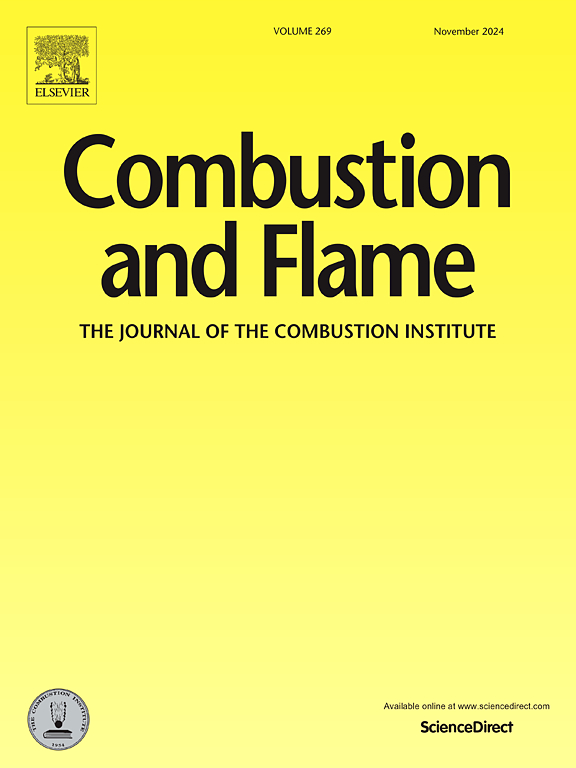Origin of self-ignition in transient release of pressurized hydrogen into a rectangular tube: Flow visualization and numerical research
IF 6.2
2区 工程技术
Q2 ENERGY & FUELS
引用次数: 0
Abstract
Self-ignition events during the transient release of pressurized hydrogen into a length of tube have been reported. Understanding the underlying mechanism is crucial for both process control and risk mitigation. This study combines flow visualization and a three-dimensional numerical simulation to investigate the origin of self-ignition within a smooth rectangular tube. The experiments eliminate the influence of tube-wall discontinuities caused by sensor arrangements in previous studies, while the simulations implement a realistic multi-step diaphragm opening scheme. The present experimental study clearly captures the boundary layer behind the leading shock within the tube in the scope of self-ignition. This finding is significant as it provides direct experimental evidence that self-ignition originates from the boundary layer. The contact surface at the head of the jet is difficult to accumulate high temperatures due to flow divergence, and the wall center is filled with a high concentration of hydrogen, making them unlikely locations for ignition initiation. The contact surface and post-shock high temperatures are stretched along the wall corners of the rectangular tube. The low-velocity flow at the wall corner promotes the accumulation of oxidizer and the mixing of cold hydrogen and hot air. Self-ignition originates from the overlapping boundary layers at the wall corner. Thin flames propagate downstream along the wall corner under limited turbulent mixing and fuel supply.
受压氢在矩形管内瞬态释放自燃的起源:流动显示与数值研究
加压氢气在一段管道内瞬间释放时发生的自燃事件已有报道。了解潜在的机制对于过程控制和风险缓解都是至关重要的。本文采用流动可视化和三维数值模拟相结合的方法研究了光滑矩形管内自燃的起源。实验消除了以往研究中由于传感器布置引起的管壁不连续的影响,而仿真实现了一种真实的多步膜片开启方案。本实验研究清楚地捕捉到了自燃范围内管内先导激波后的附面层。这一发现具有重要意义,因为它提供了直接的实验证据,证明自燃起源于边界层。射流头部接触面由于气流发散难以积累高温,壁面中心充满高浓度的氢气,不太可能发生点火。接触面和冲击后高温沿矩形管的壁角被拉伸。壁角处的低速流动促进了氧化剂的积累和冷氢与热空气的混合。自燃是由于壁面转角的边界层重叠引起的。在有限的湍流混合和燃料供应下,薄火焰沿壁角向下传播。
本文章由计算机程序翻译,如有差异,请以英文原文为准。
求助全文
约1分钟内获得全文
求助全文
来源期刊

Combustion and Flame
工程技术-工程:化工
CiteScore
9.50
自引率
20.50%
发文量
631
审稿时长
3.8 months
期刊介绍:
The mission of the journal is to publish high quality work from experimental, theoretical, and computational investigations on the fundamentals of combustion phenomena and closely allied matters. While submissions in all pertinent areas are welcomed, past and recent focus of the journal has been on:
Development and validation of reaction kinetics, reduction of reaction mechanisms and modeling of combustion systems, including:
Conventional, alternative and surrogate fuels;
Pollutants;
Particulate and aerosol formation and abatement;
Heterogeneous processes.
Experimental, theoretical, and computational studies of laminar and turbulent combustion phenomena, including:
Premixed and non-premixed flames;
Ignition and extinction phenomena;
Flame propagation;
Flame structure;
Instabilities and swirl;
Flame spread;
Multi-phase reactants.
Advances in diagnostic and computational methods in combustion, including:
Measurement and simulation of scalar and vector properties;
Novel techniques;
State-of-the art applications.
Fundamental investigations of combustion technologies and systems, including:
Internal combustion engines;
Gas turbines;
Small- and large-scale stationary combustion and power generation;
Catalytic combustion;
Combustion synthesis;
Combustion under extreme conditions;
New concepts.
 求助内容:
求助内容: 应助结果提醒方式:
应助结果提醒方式:


